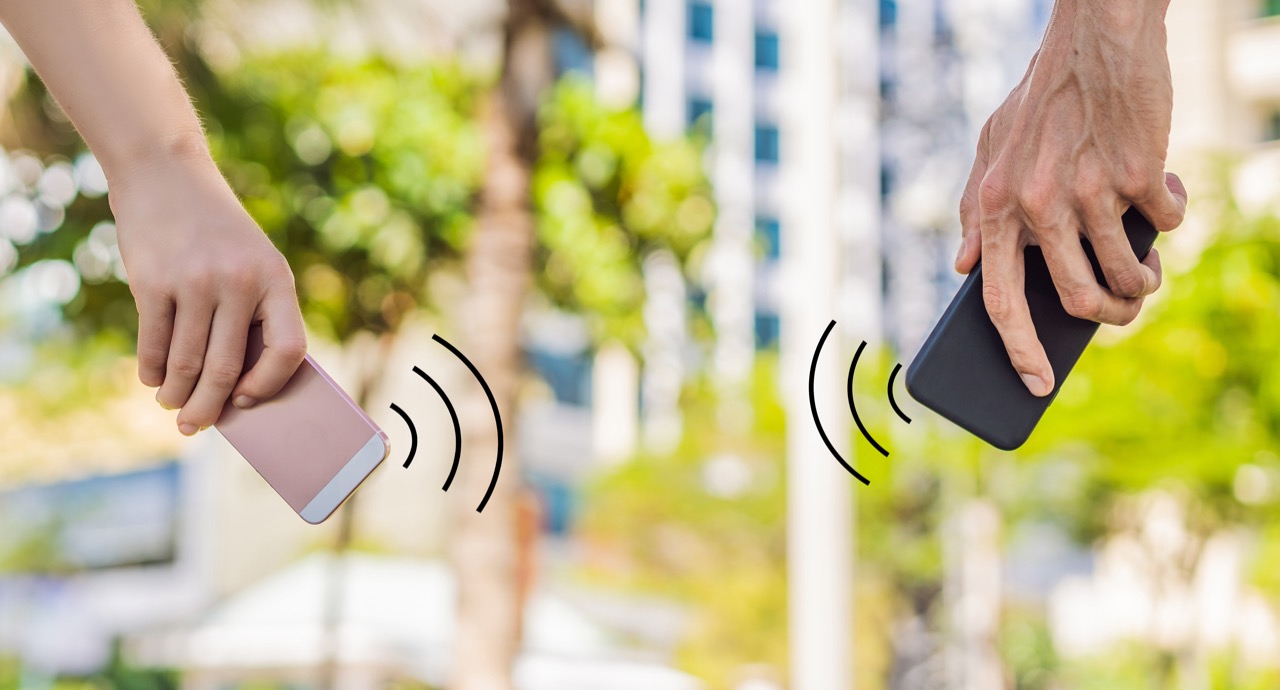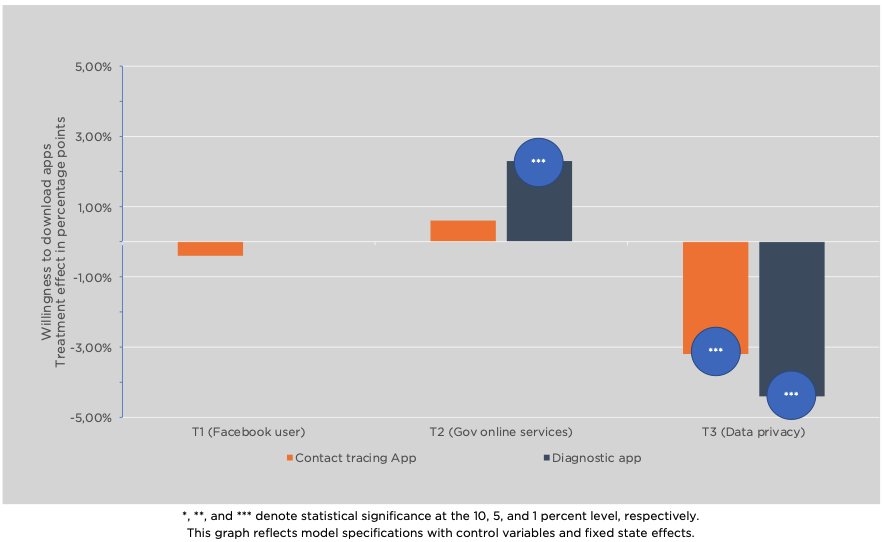Increasing the use of diagnostic and contact tracing apps

Context
The COVID-19 pandemic has demonstrated how much public policies' effectiveness depends on the willingness of citizens to undertake measures where individual private costs outweigh benefits but societal benefits outweigh public costs. One such instance of positive externalities is the use of self-diagnostic apps and contact tracing apps. The former helps individuals to identify a potential infection, while the second informs citizens about contact with known third-person virus carriers, followed by a recommendation to self-isolate. Individuals might benefit if they are informed about possible infection and take curative measures earlier than if they might have noticed a condition in the app's absence. However, the primary benefit results for societies since apps facilitate contact tracing and the interruption of chains of infections.
One frequent citizen concern regarding the apps relates to data privacy and protection. Policymakers often directly address these concerns by assuring citizens that they have undertaken all necessary measures to reduce risks. However, it is unclear if this straightforward approach resolves doubts and overcomes citizens’ hesitancy.
The Project
Research has indicated that overcoming data privacy concerns might lead to a strong increase in diagnostic and tracing apps’ uptake. Yet, literature in other fields indicates that an explicit strategy to address such concerns might backfire. Therefore, this study tests the impact of different messages on willingness to adopt diagnostic and contact tracing apps. It sought to test if explicit strategies to deal with data privacy concerns are indeed helpful or if they might lead to counterproductive effects, further decreasing willingness to download and use the apps.
The study took the form of an online experiment that was conducted in 2020 with more than 23,000 participants from the two Mexican states of Sonora and Guanajuato.
Behavioral Analysis
Behavioral Barriers
Availability heuristic: Individuals judge the probability of a future event occurring based on the ease with which an occurrence of such an event comes to mind. For instance, citizens might have recently heard about issues involving data protection and on the basis of this memory might overestimate the probability that problems might again arise.
Priming: Priming is a phenomenon in which exposure to one stimulus influences how a person responds to a subsequent, related stimulus. These stimuli are often conceptually related words or images. For example, a moment after an individual reads about measures to prevent data abuse, she might be inclined to think about the possible consequences of data abuse instead of the benefits of the app.
Salience: Our attention is limited. Therefore, behavioral economics pays special attention to the moment when a message is delivered, the location at which it is delivered, and the content it emphasizes. Explicitly mentioning a sensitive topic such as data concerns might be salient to citizens in a way that results in an aversion to engaging further with the topic.
Other Barriers
Lack of trust: Individuals who mistrust their government or their fellow citizens might refrain from using an app, for instance, because they fear misuse of their data or they do not attribute benefit to it.
Behavioral Tools
Feedback: It is an effective tool to enhance awareness of the consequences of various choices. It may fill knowledge gaps and foster the search for efficient alternatives. For instance, the app might provide individuals with feedback on their health and their contact points, facilitating an adjustment of behavior after individuals might have had contacts with people carrying the virus.
Framing effect: The tendency to draw different conclusions depending on how the information is presented. For example, information on the benefits of COVID-19 tracing or diagnostic apps can be presented in ways that to varying degrees explicitly or implicitly address data concerns, respectively eliciting different responses by participants.
Intervention Design
This study embedded a survey experiment within a larger survey dedicated to COVID-19. It consisted of four groups, one control and three treatment arms to which individuals were randomly assigned. The three treatment arms contained a priming vignette and a follow-up question that tested the effectiveness of the prime.
One of the vignettes’ primes followed the traditional approach of assuring citizens of the government’s data privacy efforts (T3). In contrast, T1 states the usefulness of Facebook as a social network, while T2 underscores the convenience of using online services and apps to conduct business with the government.
Subsequently, individuals in all four groups were asked two questions concerning the two dependent variables: their willingness to download 1) a COVID-19 diagnostic app and 2) a contact tracing app. Answers could be given according to four response categories that were later dichotomized for the analysis. The study assumed that explicitly addressing data protection concerns as in T3 might backfire, since this strategy might make data protection concerns more salient and prime individuals for the issue in ways that evokes more negative associations than possible benefits of the apps.
Participants over 18 were recruited via advertisements on the IDB Facebook page and via email lists provided by the Mexican states of Sonora and Guanajuato. The Facebook recruitment led to 15,542 usable surveys in addition to the 7,642 obtained from the email recruitment process. Jointly, the sample consisted of over 23,000 individuals.
Table 1. Conditions of the Main Survey.

Challenges
- Over 90 percent of the sample indicated they would likely or surely download a tracing app (88 percent for the diagnostic app), possibly driven by social desirability effects that are often seen in surveys. This represents two challenges. First, this number is considerably higher than in other surveys, potentially indicating that this sample does not allow for significant generalizations. Second, this creates a challenge for the intervention and the experiment’s statistical power since ceiling effects limit the ability to increase uptake to find sizeable effects.
Results
The following results were obtained from linear regressions with three parameters of the conditions T1 to T3, with the control group as baseline category.
- Results indicate that traditional approaches that explicitly address data protection efforts might backfire (Figure 1). Individuals assigned to T3, which referred to government efforts to ensure data privacy, were 4 percentage points (pp) less likely to indicate a willingness to download the diagnostic app and 3 pp for the contact tracing app.
- Individuals who were successfully primed for conditions T1 and T2 indicated a higher willingness to download both apps than those that were not, while successful primes for T3 (government efforts for data protection) led to a lower share of respondents indicating to be highly likely to download the apps.
- T1, which referred to the usefulness of Facebook, did not have any significant effect. In contrast, T2 significantly increased participants’ willingness to download the diagnostic app by 2 pp. This is an indication that a strategy that indirectly addresses the issue by outlining benefits of apps in other fields might be more promising than a direct one.
- Control variables point out baseline differences across subpopulations. Older and more educated individuals are less likely to indicate willingness to download the apps. In contrast, women and those who have had direct or indirect experiences with COVID-19 were more likely to download the app. Finally, people who perceived being likely to require hospitalization who perceived indoor activities as risky displayed greater willingness to download the apps.
Figure 1. Treatment Effects of Different Message Primes on Willingness to Download COVID Diagnostic and Tracing Apps in Main Survey.

Policy Implications
- Policy makers are often faced with citizen concerns on issues such as data privacy. However, this study showed that directly addressing such concerns might lead to a knee-jerk reaction that is triggered by the prime on data concerns. Instead of overcoming these concerns, they come to the top of the citizens’ minds.
- A strategy that indirectly addresses the issue by outlining benefits of apps in other fields might be more promising than a direct one.
- In more general terms, the study demonstrated in yet another context the high effectiveness of primes as means of influencing behavior.
